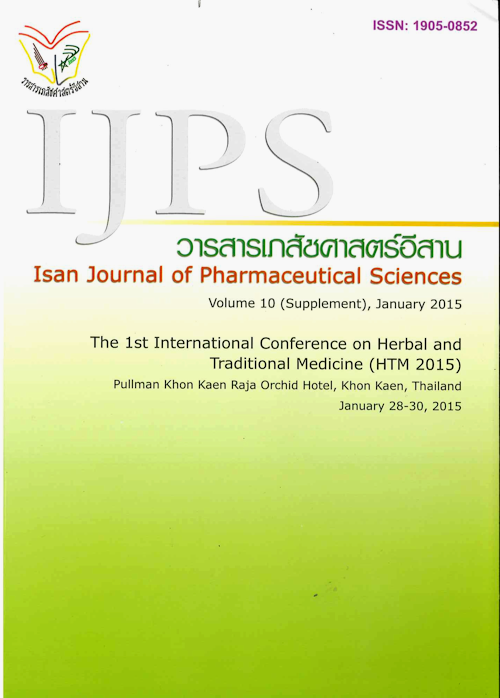Phytochemicals, and Anti-oxidative DNA Damage Activity Against H2O2 of Nymphaea lotus Linn. Flowers Ethanolic Extracts
Main Article Content
Abstract
The common name in Thailand is called “BuaSai” and has been used a part of stem as vegetable. For
the part of the fl owers used as one kind of ingredients in a Thai traditional recipe called Yahom.
Methods: The phytochemical contents of N. lotus fl owers were analysed using HPLC technique
comparing with authentic standard. The evaluation of antioxidant activity in ethanolic extract of N. lotus
fl owers using the 2,2-Diphenyl-1-picrylhydrazin (DPPH) radical scavenging assay and lipid peroxidation
(b-carotene bleaching model). The anti-oxidative DNA damage was performed following pre-treatment
TK6 cells with extracts at concentration of 37.5, 75 and 150 μg/mL for 24 hr follow by H2O2 induction.
Results: The ethanolic extracts of N. lotus fl owers were composed of phenolic and fl avonoid compounds
such as gallic acid, corilagin, geraniin, ellagic acid, kaempferol-3-β-D-glucopyranoside and quercetin.
Anti-oxidant activity value (EC50 ) was 1.56 μg/mL and 2.8 μg/mL that determined using DPPH and
β–carotene bleaching assay, respectively. The range of those concentration was showed as the dose
response of DNA protective effect at the percentage of 56.55±4.87, 90.96±0.97 and 93.53±0.78.
Conclusion: N. lotus fl owers extract showed high potent of anti oxidative DNA-damage activity due to
phenolic and fl avonoid compounds in crude extracts. Thus, the N. lotus fl owers extract could be used
as anti-aging agent in nutraceutical and cosmetic applications.
Article Details
In the case that some parts are used by others The author must Confirm that obtaining permission to use some of the original authors. And must attach evidence That the permission has been included
References
Afolayan A.J, Sharaibi O.J and Kazeem M.I. Phytochemical Analysis and in vitro Antioxidant Activity of Nymphaea lotus L. Int. J. Pharmacol. 2013; 9(5): 297-304.
Duan X.J, Zhang W.W, Li X.M, Wang B.G. 2006. Evaluation of Antioxidant Property of Extract and Fractions Obtained from a Red Alga, Polysiphoniaurceolata. Food Chem 2006; 95: 37-43.
EmenS, Ceken B, Kizil G and Kizil M. DNA damageprotecting activity and in vitro antioxidant potential of the methanol extract of cyclotrichiumniveum, Pharm Biol 2009; 47(3): 219-229.
Kawaree R, Okonogi S, Chowwanapoonpohn S and Phutdhawong W. Chemical Composition and Antioxidant Evaluation of Volatile Oils from Thai Medicinal Plants. Proceedings of the International Workshop on Medicinal and Aromatic Plants. ISHS 2008; 786: 209-215.
Klungsupya P, Saenkhum J, Muangman T, Rerk-am U, Laovithayanggoon S, and Leelamanit W. 2012. Non-Cytotoxic property and DNA protective activity against H2O2 and UVC of thai GAG fruit extracts in human TK6 cells, JAPS 2012; 2(4): 4-8.
Madhusuddhanan N, Lakshmi T, Gowtham Kumar S, Ramakrishanan, VenuGopalaRao Konda, Anitha Roy. and Geetha R.V. Invitro Antioxidant and Free Radical Scavening Activity of Aqueous and Ethanolic Flower Extract of Nymphaeae alba. IJDDR 2011; 3(3): 252-258.
Sowemimo A.A, Omobuwajo O.R and Adesanya S.A. Constituents of Nymphaea lotusLinn. Nig. J. Nat. Prod. and Med.2007; 11: 1-2.
Thippeswamy B.S, Mishra B, Veerapur V.P and Gupta G. Anxiolytic activity of Nymphaea alba Linn. in mice as experimental mod-els of anxiety. Indian J. Pharmacol 2011; 43: 50-55.


